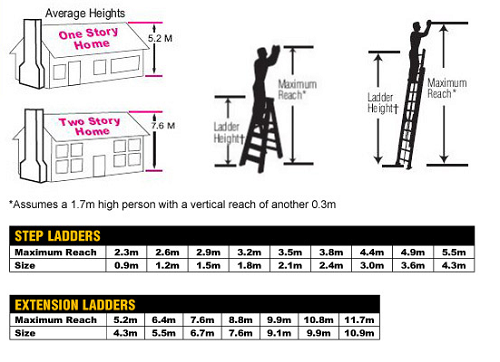Climbing Equipment
Why should I buy a Werner Ladder?
Focusing on end users' needs is what drives Werner’s success. Our entire product design process from engineering to manufacturing creates a climbing system that ensures productivity, durability and safety for the user. On jobsites across the world, Werner is preferred more than any brand because innovation, safety and durability are built into every product.
How do I know that a ladder is of a minimum quality standard?
Ladders sold in Australia and New Zealand are to be manufactured under the standards set out by the “Australian and New Zealand Standards” committee for ladders. These standards specify the communities’ expectations in relation to the
products minimum safety and quality. The applicable standards are:
- AS/NZS 1892: Portable Ladders
- Part 1: Metal
- Part 2: Timber
- Part 3: Reinforced Plastic
- Part 5: Safe Use and Care
What is the difference between a ‘Domestic’ and an ‘Industrial’ duty rated ladder?
As stated in the Australian/NewZealand Standards (AS/NZS 1892.1-5), an ‘Industrial’ ladder must have a minimum load rating of 120kg and be labeled that it is suitable for Industrial use.
A ‘Domestic’ ladder must have
a minimum load rating of 100kg and be labeled that it is suitable for Domestic use.
Can I use a ‘Domestic’ Duty Rated ladder at my work place?
In short, NO. A ‘Domestic’ ladder is NOT suitable for use in a workplace or in a commercial environment.
Only ‘Industrial’ ladders with a load rating of 120kg or higher can be used in a work environment - this includes
building sites, factories, shops and offices. Note: Shops and offices are commercial workplaces and require 'Industrial’ rated ladders.
What is the difference between a Fibreglass and an Aluminium Ladder?
Fibreglass ladders are used where an electrical hazard exists. It is recommended and in most cases mandatory to use fibreglass instead of aluminium. Fibreglass ladders provide isolation between the user and the earth, reducing (but not eliminating) the risk of electrocution.
How do I select the correct ladder for the job I need to do?
STEP 1:CHOOSE THE HEIGHT
Choose the correct height of the ladder that you need for your job. The table below shows the maximum reach for several ladder heights assuming a 1.7m person with a vertical reach of another 0.3m.

When using extension ladders for access to or from a roof, the ladder should protrude at least 1.0m above the highest support point such as the roof line.
STEP 2: CHOOSE THE APPLICATION
If you are going to use the ladders for commercial purposes, you must use Industrial rated ladders with a minimum load rate of 120 kg.
However, if you are going to use the ladders at a private
dwelling for non-commercial purposes, you can use Domestic ladders. Domestic ladder should have a minimum load rating of 100 kg.
Note: The load rate includes the is the total combined weight of the person, the tool/equipment and materials
that the user is carrying.
STEP 3: CHOOSE LADDER STYLE
Choosing the correct ladder for the style of job you are doing is important. Take the time to understand the different styles available. This may include Single
Sided, Double sided, Platform Step Ladders, Dual Purpose, Extension Ladders or Mobile scaffold.
Remember!! If you are working with or around electricity you should be using a Fibreglass product.
The highest permitted standing level on a step ladder is the third step from the top. Standing higher than that may cause you to lose balance and fall.
What should I do before I use my ladder?
It is recommended that your ladder/s be inspected prior to use. The following should be undertaken:
- Check for damage or missing components.
- Check for loose or missing bolts or rivets.
- Check ladder feet for excessive wear.
- Check ropes are not fraying and are securely attached.
- Check that ladder stiles/rungs/treads are straight.
- Check spreaders are in good order.
- Check that the ladder is free from dust, water, grease and corrosion.
- Clean a ladder with mild soapy water and ensure it is dry prior to use.
- Check timber ladder for splits, rot, and insect infestation.
- Never paint a timber ladder use a clear varnish suitable for exterior or marine environments so that defects are not hidden.
- Store ladders in a dry, covered location.
- Exposure to excessive heat may weaken a ladder.
- If the ladder has sustained a blow or impact carefully check the ladder for defects prior to next use.
- Fibreglass ladders will over time degrade and fibres may become exposed. Wash the ladder with a commercial solvent and apply enough coats of polyurethane or clear acrylic lacquer to encapsulate the fibres.
How do I transport my ladder safely?
When transporting a ladder on a vehicle ensure that the following points are observed:
- The ladder is supported along its length to prevent sagging.
- The overhang beyond supports is equal and less then 1/3 of the length of the ladder.
- The ladder is securely tied down to prevent road shock and chaffing. Do not over tighten as this may damage the ladder.
- The upper surface of the roof racks or supports should be covered with soft material, such as rubber or pine, to decrease road shock.
How do I repair my damaged ladder?
For the safety of the user Werner Co. does not recommend repairing a damaged ladder and does not offer a repair service through the company.
Where can I get information about ladder safety?
We encourage you to explore our online guides and training resources.
Where can I find more details on how to install my attic ladder?
You can find installation videos on our YouTube channel.
